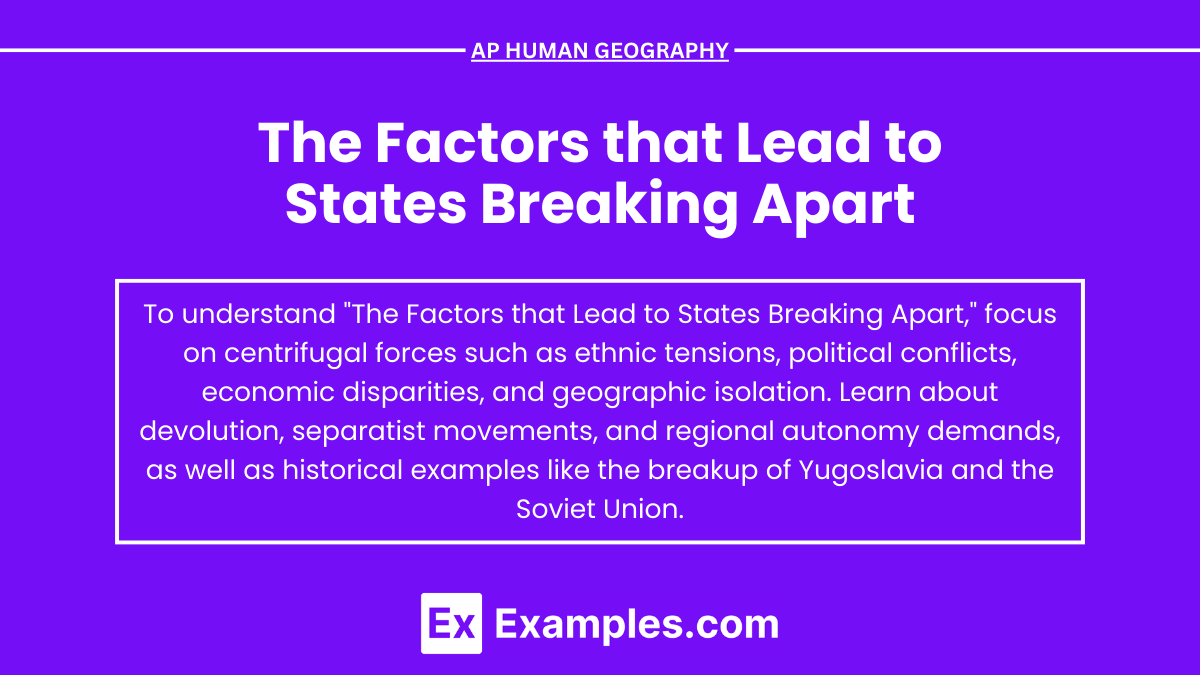The breakup of states occurs due to a complex interplay of cultural, political, economic, and geographic factors, a critical topic in AP Human Geography. Ethnic tensions, economic disparities, weak governance, and political instability often drive regions to seek autonomy or independence. Historical legacies, such as colonial boundaries, and external influences, including foreign intervention, can exacerbate internal divisions. Geographic isolation and resource conflicts further contribute to fragmentation. Understanding these factors is crucial for analyzing state disintegration and regional autonomy movements, key themes in AP Human Geography.
Learning Objectives
When studying “The Factors that Lead to States Breaking Apart” for AP Human Geography, you should aim to understand how ethnic, cultural, and religious divisions can drive separatism. Focus on how economic disparities, political instability, and weak governance contribute to fragmentation. Analyze the roles of geographic isolation, colonial legacies, and external influences in state breakups. Additionally, explore the impact of social pressures, such as demographic changes and environmental stress, on regional independence movements. These factors collectively shape global political fragmentation and secessionist trends.
The breakup of states, or the process of fragmentation, can occur due to a combination of political, cultural, economic, and geographic factors. Understanding these influences in the context of AP Human Geography is critical. Here are detailed notes on the factors that lead to states breaking apart:
1. Ethnic and Cultural Divisions
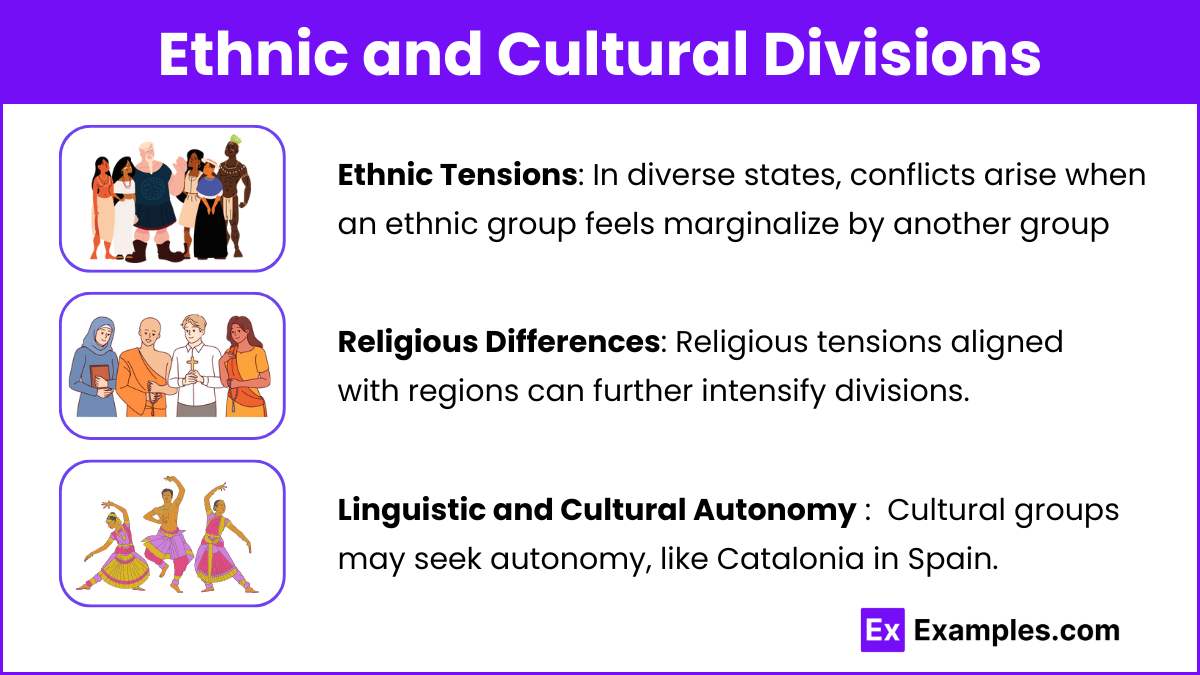
- Ethnic Tensions: States with diverse populations often face conflicts when one ethnic group feels marginalized by the dominant group. This is common in multi-ethnic states, where power imbalances lead to secessionist movements. For example, the breakup of Yugoslavia in the 1990s was largely driven by ethnic divisions.
- Religious Differences: Religious tensions, when aligned with ethnic or regional identities, can further drive division. The partition of India and Pakistan in 1947 is a key historical example where religious differences led to the formation of new states.
- Linguistic and Cultural Autonomy: Groups within a state that speak different languages or have distinct cultural practices may seek greater autonomy or independence, as seen with the Catalan independence movement in Spain.
2. Economic Disparities
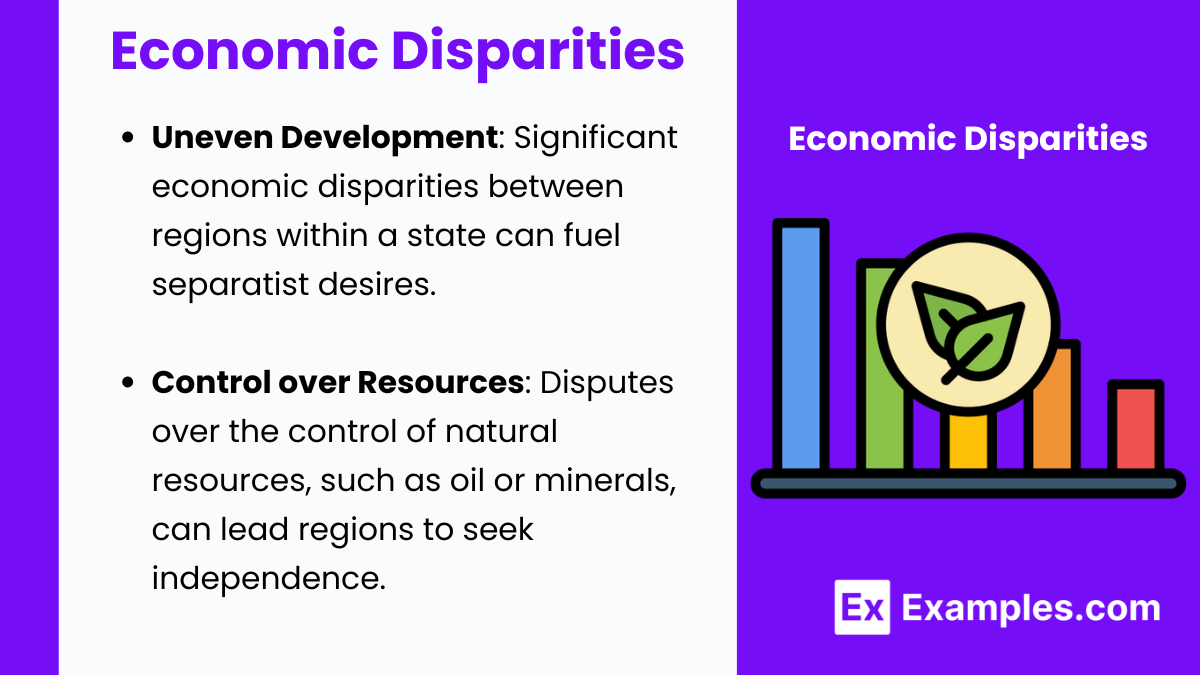
- Uneven Development: Significant economic disparities between regions within a state can fuel separatist desires. Wealthier regions may feel that they contribute more to the national economy without receiving proportional benefits, while poorer regions may feel neglected. For instance, Italy’s northern regions have pushed for greater autonomy due to perceived economic advantages over the south.
- Control over Resources: Disputes over the control of natural resources, such as oil or minerals, can lead regions to seek independence. Sudan’s civil wars, leading to the eventual independence of South Sudan, were partially fueled by disputes over oil reserves.
3. Political Instability and Governmental Weakness
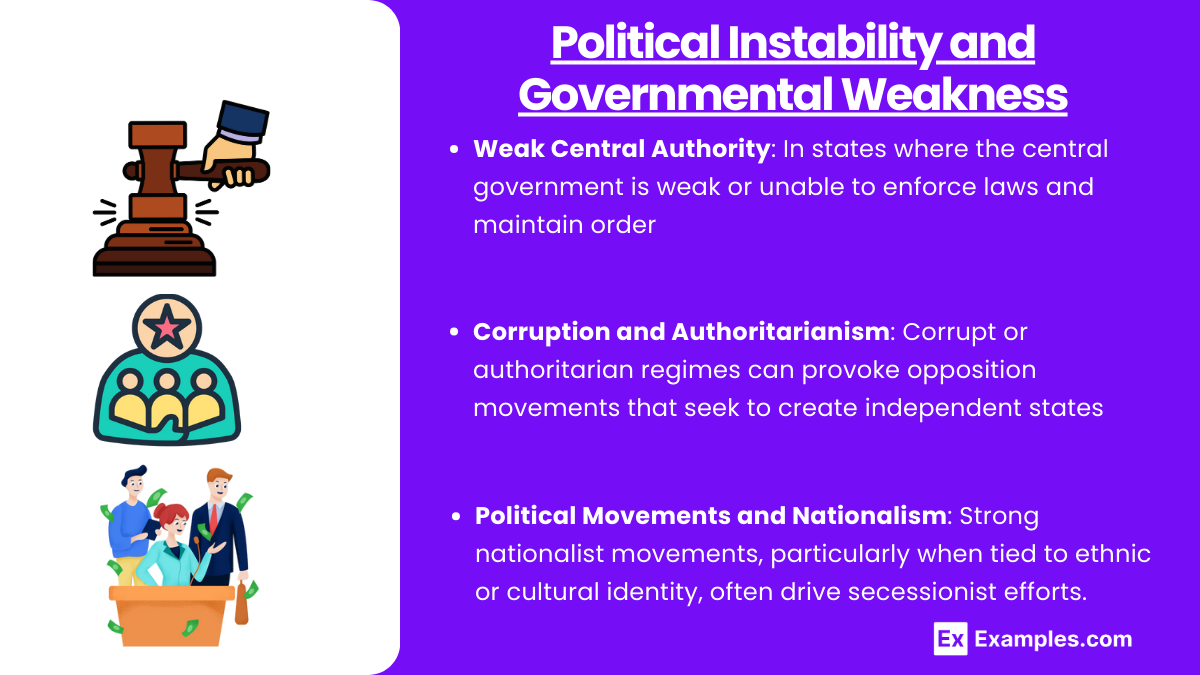
- Weak Central Authority: In states where the central government is weak or unable to enforce laws and maintain order, regions may break away. This is often seen in fragile states or those with ongoing conflicts. Somalia, for instance, has experienced fragmentation due to the central government’s inability to maintain authority.
- Corruption and Authoritarianism: Corrupt or authoritarian regimes can provoke opposition movements that seek to create independent states where democracy or fair governance is more achievable. The collapse of the Soviet Union is a prime example, where authoritarian control and economic mismanagement led to the emergence of several independent states.
- Political Movements and Nationalism: Strong nationalist movements, particularly when tied to ethnic or cultural identity, often drive secessionist efforts. This can be exacerbated by historical grievances or aspirations for self-rule.
4. Geographic Isolation and Physical Barriers
- Geographic Distance: Regions that are geographically distant from the capital or core areas of a state may feel disconnected and develop a unique regional identity. For example, East Timor’s geographical isolation from Indonesia contributed to its successful push for independence.
- Natural Barriers: Mountains, rivers, and other natural barriers can isolate regions and limit interaction, contributing to a sense of separation. This geographic isolation can reinforce cultural differences and lead to demands for autonomy.
5. Colonial Legacies and Artificial Boundaries
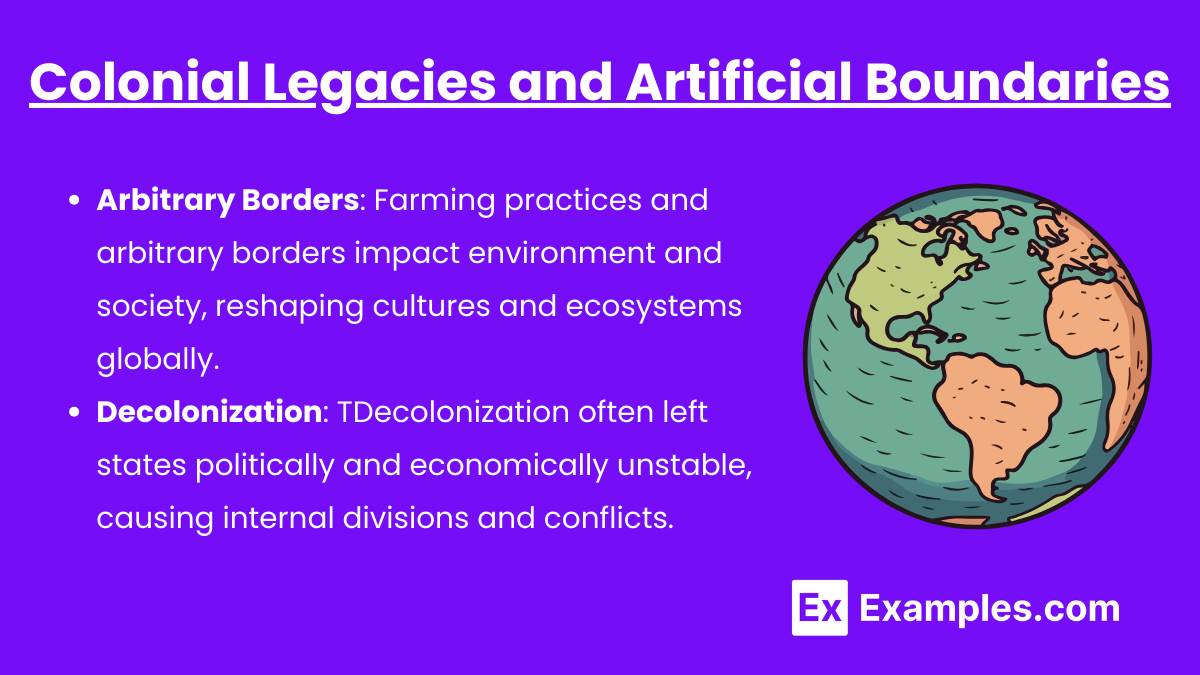
- Arbitrary Borders: Many modern states, particularly in Africa and the Middle East, were shaped by colonial powers that drew arbitrary borders without considering ethnic or cultural divisions. As a result, ethnic groups were divided or forced to coexist within the same state, leading to post-colonial conflicts and potential fragmentation. The breakup of Sudan and the ongoing challenges in countries like Nigeria are examples of this issue.
- Decolonization: The process of decolonization often left behind states that were not politically or economically stable, leading to internal divisions. Many newly independent states in Africa and Asia struggled with ethnic divisions and power struggles that sometimes led to fragmentation.
Examples
Example 1. Ethnic Tensions in Yugoslavia
Yugoslavia was a multi-ethnic state made up of several distinct groups, including Serbs, Croats, Bosnians, and Albanians. Ethnic tensions, exacerbated by political and economic instability, led to the eventual disintegration of the state in the 1990s. The rise of nationalist movements among these groups and the brutal conflicts that followed, such as the Bosnian War, illustrate how ethnic divisions can fracture states.
Example 2. Economic Disparities in Italy
In Italy, the north-south divide has been a long-standing issue. Northern Italy is wealthier and more industrialized compared to the poorer, agrarian south. The economic disparities between the two regions have fueled regionalist movements, such as the Northern League, which advocates for greater autonomy or even secession. This is an example of how uneven economic development can drive regions within a state to seek independence or autonomy.
Example 3. Colonial Legacies in Sudan
Sudan’s borders were drawn during the colonial period without consideration for ethnic and religious differences. After gaining independence, the country faced ongoing conflict between the predominantly Muslim north and the largely Christian and animist south. These divisions, combined with disputes over oil resources, eventually led to the secession of South Sudan in 2011, showcasing the long-term impact of colonial-era boundaries on state fragmentation.
Example 4. Weak Central Authority in Somalia
Somalia has experienced prolonged political instability since the collapse of its central government in 1991. With no effective national government, the country has fragmented into autonomous regions such as Somaliland and Puntland. These regions operate independently, and efforts to reestablish a unified Somali state have been largely unsuccessful. Somalia’s case highlights how weak central authority and governance can lead to state fragmentation.
Example 5. Geographic Isolation in East Timor
East Timor, located on an island far from the Indonesian capital of Jakarta, had a distinct cultural and historical identity separate from the rest of Indonesia. The geographic isolation, combined with political and religious differences, contributed to its successful bid for independence in 2002. This is an example of how geographic distance and isolation can drive regions to break away from a state.
Multiple Choice Questions
Question 1
Which of the following is most likely to cause a state to break apart due to ethnic divisions?
A) Natural resource abundance in the capital region
B) Geographical proximity to neighboring countries
C) Marginalization of minority ethnic groups by a dominant group
D) Strong central government with fair representation for all ethnic groups
Correct Answer: C) Marginalization of minority ethnic groups by a dominant group
Explanation: When a dominant ethnic group marginalizes minority groups, tensions arise, often leading to calls for autonomy or independence. This marginalization creates feelings of exclusion and injustice, fostering movements that may push for the breakup of a state. This is seen in historical examples like Yugoslavia, where ethnic tensions between Serbs, Croats, and Bosniaks led to the country’s fragmentation. Other options, such as resource abundance or geographical proximity, do not inherently cause states to break apart.
Question 2
What role do colonial legacies often play in the fragmentation of modern states?
A) They typically leave behind well-defined ethnic boundaries that foster unity.
B) They create arbitrary borders that ignore ethnic and cultural divisions, leading to internal conflict.
C) They ensure equitable distribution of resources among regions within a state.
D) They promote the integration of multiple ethnic groups into a single national identity.
Correct Answer: B) They create arbitrary borders that ignore ethnic and cultural divisions, leading to internal conflict.
Explanation: Colonial powers often drew borders without considering the ethnic, linguistic, or cultural realities of the regions they controlled, resulting in the creation of states with deep internal divisions. For example, in Africa and the Middle East, these artificial boundaries often split ethnic groups or forced rival groups to coexist within the same state. This legacy of division can lead to conflicts and the eventual breakup of states. Other answers, such as equitable resource distribution or fostering unity, do not reflect the typical colonial experience.
Question 3
How can economic disparities between regions within a state contribute to its breakup?
A) By causing wealthier regions to feel they are being unfairly treated and underrepresented
B) By ensuring the fair distribution of wealth among all regions, which promotes stability
C) By creating a unified economic system that benefits both wealthy and poor regions equally
D) By reducing the influence of foreign powers on domestic politics
Correct Answer: A) By causing wealthier regions to feel they are being unfairly treated and underrepresented
Explanation: Economic disparities within a state can lead to wealthier regions feeling that their resources are being disproportionately distributed to poorer areas, without sufficient representation in government decisions. This can lead to secessionist movements where wealthy regions seek greater autonomy or independence. For example, Northern Italy has often sought more independence due to its economic advantages over the southern part of the country. The other options suggest scenarios that would more likely contribute to state unity rather than division.

